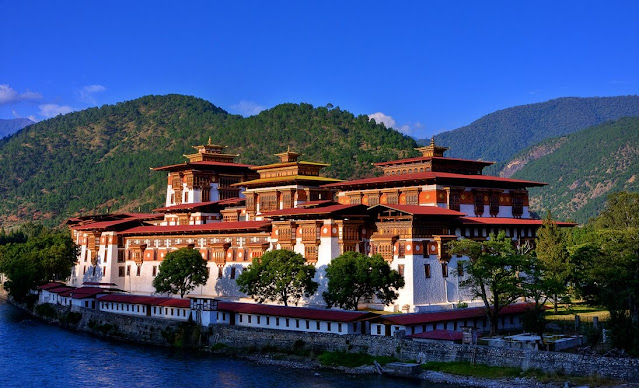The Punakha Dzong is also known as Pungthang Dewa chhenbi Phodrang which means "the palace of great happiness or bliss", is the administrative centre of Punakha District in Punakha, Bhutan. The dzong was constructed by Zhabdrung Ngawang Namgyal, first Zhabdrung Rinpoche (also the founder of the country) in 1637–38.
It is the second oldest and second largest dzong in Bhutan and one of its most majestic structures. The dzong houses the sacred relics of the southern Drukpa Lineage of the Kagyu school of Tibetan Buddhism, including the Rangjung Kasarpani and the sacred remains of Ngawang Namgyal and the tertoen Pema Lingpa.
Punakha Dzong is the administrative and the religious centre of the district.
The Dzong is located at the confluence of the Pho Chhu (father) and Mo Chhu (mother) rivers in the Punakha–Wangdue valley. The source of the Mo chu river is in the northern hills of Ligshi and Laya in Bhutan, and in Tibet. The Pho Chu River is fed by glaciers in the Lunana region of the Punakha valley. After the confluence of these two rivers, the main river is known as Puna Tsang chu.
In view of the healthy climate in the region, Punakha is the winter capital of Bhutan. Punakha is also the center of Bhutan’s longest suspension bridge (Punakha Suspension Bridge) and is about 7.5 km (4.5 miles) by car to Chimi Lhakhang, the Divine Madman’s fertility temple.
Architecture
main enternce
It is a six-storied structure with a central tower at an average elevation of 1,200 metres (3,900 ft) with a scenic, mountainous background. The materials used in the construction of the Dzong consisted of compacted earth, stones and timber in doors and windows.
Interior
 |
| courtyard |
After the dzong suffered damage due to a fire, a large prayer hall was added in 1986.
In 2008 the coronation of His Majesty King Jigme Khesar Namgyel Wangchuck took place in the Punakha Dzong. The Dzong has been the venue for coronation of all the kings of Bhutan. Moreover, it has also witnessed the grand royal wedding of the country.



Comments
Post a Comment